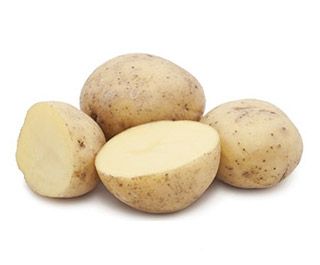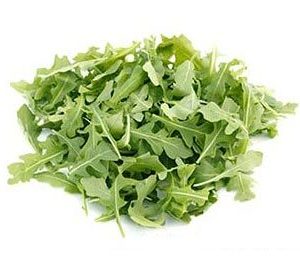Whether it’s mashed or baked, boiled or steamed, fried or sautéed, the potato is a dietary staple around the globe. This root vegetable is a member of the Solanaceae (or nightshade) family, whose members include eggplants, peppers and tomatoes. If allowed to fully grow, the potato plant can produce an inedible fruit that resembles a tomato.
Potatoes originated from South America, specifically in the Andean mountain region. They were later introduced to Europeans by Spanish explorers in the 16th century. On many of their voyages, the Spanish used potatoes as a source of vitamin C to combat scurvy. Today, this vegetable is cultivated worldwide and is the world’s fourth most important crop, with the states of Idaho and Washington as its largest producers.
There are about 200 types of potatoes sold in the United States today, each varying in shape, size, color, flavor and nutritional content. The most common types are white, yellow, red and russet potatoes.
Potatoes are different from sweet potatoes, regardless of their many similarities. Sweet potatoes appear in various colors, including cream/white, orange and purple. On the other hand, regular potatoes have a white or pale yellow flesh with brown, red or tan skins. Their nutritional profiles also differ from each other; Regular potatoes are high in starches, while sweet potatoes have higher amounts of sugar in the form of sucrose. However, sweet potato outshines potato in the micronutrients department; according to Nutritics, sweet potatoes rank higher in 10 out of 12 nutrients they tested compared to potatoes. These nutrients include iron, calcium and magnesium, as well as vitamins A and C.
Some varieties of potatoes can be a bane to your health, especially if they’re fried. However, moderate consumption amounts and healthful cooking methods can maximize their benefits. Plus, potatoes are very affordable and extremely versatile in the kitchen.
Health Benefits of Potato
Nowadays, potatoes are commonly sold and consumed in the form of greasy French fries or baked potato chips. These processed products are a source of unhealthy fats like trans fat, as well as other processed ingredients and chemical additives. Excessive consumption of processed potatoes may lead to myriad health problems, including obesity, heart problems and even cancer.
Minus the unhealthy oils and fats, potatoes are low in calories, and provide fiber and several nutrients. Potatoes are a good source of soluble and insoluble fiber, and this may help inhibit constipation and lower LDL cholesterol levels.
Potatoes are one of the most abundant sources of B-vitamins, especially vitamin B6 or pyridoxine, thiamin, niacin, pantothenic acid and folate. They’re also a great source of minerals like manganese, phosphorus, copper, potassium, magnesium and iron. Phytonutrients with antioxidant effects, such as flavonoids and phenolic acids, can also be found in these tubers.
Take note, however, that cooking methods play a big role in significantly maintaining — and depleting — potatoes’ nutritional content. Avoid frying potatoes, especially in vegetable oils. Boiling or baking potatoes is a better option.
What’s more, potatoes contain sugar-binding plant proteins called lectins, which act as “antinutrients” that can wreak havoc on your microbiome. Cooking can neutralize the lectins in potatoes, reducing them by 50% to 60%. You can learn more about lectins here.
| Potato Nutrition Facts
Serving Size: 3.5 ounces (100 grams), flesh and skin, raw |
||
| Amt. Per Serving |
% Daily Value* |
|
| Calories | 77 | |
| Calories from Fat | 3 | |
| Total Fat | 0.09 g | |
| Saturated Fat | 0 g | |
| Trans Fat | ||
| Cholesterol | 0 mg | |
| Sodium | 6 mg | |
| Total Carbohydrates | 68 g | |
| Dietary Fiber | 2.1 g | |
| Sugar | 0.82 g | |
| Protein | 2.05 g | |
| Vitamin A2 IU | Vitamin C | 19.7 mg |
| Calcium12 mg | Iron | 0.81 mg |
Studies on Potato
One study conducted by scientists from the Institute for Food Research found that potatoes provide compounds called kukoamines, which aid in lowering blood pressure. These were previously believed to only be found only in an exotic Chinese herbal plant called Lycium chinense, which is used in Chinese infusion herbal medicine. Researchers also stated that both potatoes and the Lycium chinense belong to the same plant family, and that the beneficial compounds were also found in tomatoes.
Potato Fun Facts
Back in the late 1800s, during the Gold Rush, potatoes were as valuable as gold because of their vitamin C content. They were in fact traded for this precious metal, ounce for ounce.
In October 1995, the white potato became the first crop to be grown in outer space. This was a joint project by NASA and the University of Wisconsin, Madison. Researchers came up with this technology to feed astronauts on long space voyages, and in the hope that it can sustain future space colonies.
Summary
In the time of the Spanish conquistadors, potatoes were already a favorite for their nutritional profile, versatility in cooking and affordable price. These tubers come in various shapes, sizes, color and flavors. Potatoes are rich in vitamins A and C, and B vitamins, as well as certain types of minerals. Some varieties even have phytonutrients that have antioxidant properties.
While they provide numerous beneficial properties, potatoes should only be consumed in moderation and cooked properly, as they contain lectins. Processed potatoes, such as chips and French fries, should be strictly avoided as they contain unhealthful fats and synthetic ingredients that can harm your health.







Reviews
There are no reviews yet.